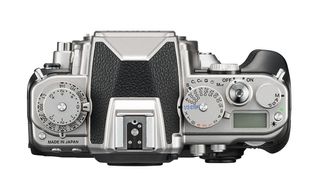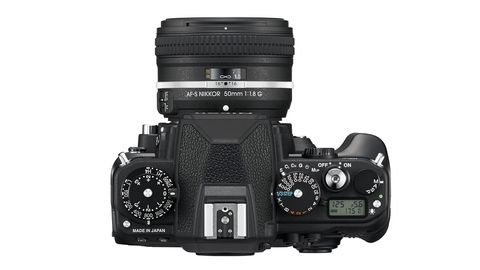Why you can trust TechRadar
While it is quite chunky, the Df is noticeably smaller than the D4. It's about the same size as the D610, but with a more angular design that is said to be based on the FM2.
It's perhaps a little unfortunate that the Df has arrived at the same time as the Sony A7 and A7R which also have full-frame sensors, but are significantly smaller. However, although these cameras have a retro look and control layout, they are compact system cameras, so they don't have a mirror and the viewfinder is electronic.
Although the link to past Nikon SLRs is clear, modern materials and small elements of design give away that the Df is a modern camera. It's superbly retro, yet is weather sealed to the same standard as the Nikon D800. Though it has to be said that the faux-leather coating on the pentaprism housing is unconvincing and a little cheap looking.

Nikon wants using the Df to be as important and enjoyable as the images it creates. Key settings such as shutter speed, sensitivity and exposure compensation can all be set by dials on the top-plate. However, the shutter speed dial has a 1/3 Step setting which when selected allows users to adjust shutter speed using the rear command dial above the thumbrest.
A locking button at the centre of the exposure compensation dial must be pressed before either of the dials can be rotated. Similarly, there's a lock button the side of the sensitivity dial, which sits below the exposure compensation dial. Although these might seem fiddly at first you soon get used to using them. However, the small exposure mode dial (marked M,A,S,P) is a little awkward to use as it needs to be raised to be rotated and it's hard to grasp, especially with cold fingers.
There's also a lock button at the centre of the shutter speed dial on the right of the top-plate, but this only comes into play when the control is rotated to the 1/3, X or T settings. Although the dial can rotate freely when it's set to one of the shutter speeds or B (Bulb), it stays put fairly well and doesn't get knocked out of position easily. We also found the drive mode dial, which sits under the shutter speed dial, tends to hold its position well despite not having a lock.

For those unfamiliar with the options on the shutter speed dial, X stands for flash sync, T for timed exposure (the shutter stays open until the release is pressed a second time) and in bulb exposure mode the shutter stays open as long as the release is held down.
In another nice touch, the shutter release has a thread at its centre to accept a traditional-style cable release.
Focus mode is set in the same way as on Nikon's other recent SLRs, via a switch to the side of the lens mount. This switch has a button at its centre which when pressed and used in conjunction with the front and rear control dials allows the AF options (Single-AF, Continuous-AF, etc) to be selected.
It's nice to see a return to a switch on the back of the camera to set the metering mode, and a button on the front of the camera which is used in conjunction with the command dials to set the bracketing options.

One concern we had is that the strap-lugs on the right as you hold the camera seem to be in the wrong place. They're above the grip, which means the grip isn't as tall as it could be and the strap can get in the way when reaching for the shutter release. However after using the camera extensively, we're happy to say that it's not as problematic as we thought it might be.
It depends how you like to carry the camera. We tend to put the strap over our shoulders or wrap it around our hands, but in most instances we found that we could reach the shutter release quickly and easily. Those who carry the camera around their necks may find it a little more awkward at first.
While the Df feels rugged and survived a few rain-showers during our testing, it's rather worrying that the battery-bay door fell off a few times when the lock was open. It feels solid enough and seemed to snap back on satisfactorily, but we picked the camera up on more than a couple of occasions to see the door lying on the table-top.
Another issue is that it's easy to forget that the camera is set to Auto ISO sensitivity control mode and make the mistake of assuming that the value indicated by sensitivity dial on the top of the camera is correct. Similarly, the position of the shutter speed dial is misleading when the exposure mode dial is set to aperture priority of program mode.

Not surprisingly, given it's the same unit as inside the D4, the Df's viewfinder is nice and bright, and capable of showing plenty of detail. This may be appreciated by owners with a collection of manual focus lenses, but they will be disappointed that the focusing screen isn't interchangeable.
One issue with the viewfinder is that if your eye is a little too high to it, the top of the information display at the bottom is cut-off.

